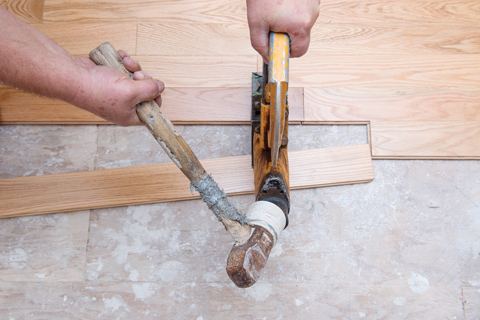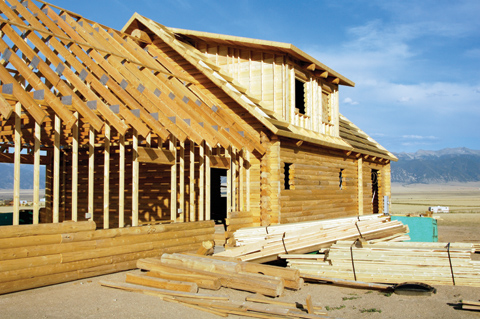Serious research, careful planning, and good old sweat equity help put the brakes on cost when building that perfect log home. Each lends itself to a more reasonable bottom line, bringing value and satisfaction to the process while potentially lowering the “hassle factor.”
While research and planning are basic, some log home owners choose to invest their own talent and expertise during the construction process, performing certain tasks themselves rather than paying a premium for contracted services. From a comprehensive perspective, considering everything from blueprints to landscaping to bathroom fixtures pays off with a potentially lower price tag.
“First of all, devote enough time to having an accurate set of plans drawn that represent the actual house you will build,” advises Curtis Hare, national sales director of Sloan’s Mill Log & Timber Homes and a retired log and timber contractor with more than 30 years of experience. “Getting quotes directly from subcontractors and suppliers that you can use to formulate an accurate budget need to be based on those plans, or you will find yourself going over budget quickly.”
Then comes the do-it-yourself element. Acknowledge limitations and remember that getting in too deep will inevitably cost more. “Determine what scope of the work you either have the expertise to truly perform or have the time to perform,” adds Hare. “It has been my experience that owner-builders can typically save the most by using qualified subcontractors to execute the plumbing, HVAC, and electrical items but handle items such as painting, staining, and interior trim themselves, as well as cleanup and trash removal.”
Individuals may logically apply their skills where possible in completing their log home. Obviously, a licensed electrician should be qualified to perform the wiring work on his or her own log home. For others, however, such work—along with plumbing, structural requirements, and more—often must be completed according to specific building codes that vary from one location to another.
“The things people can do to save money will depend on their construction background and skill level,” comments Dorie Workman, a vice president with Appalachian Log Structures. “A few of the simplest projects could include finishing and staining exterior log walls, interior log walls, and beams, and tongue and-groove wood ceilings; painting any interior drywall or trim; and assembling and installing basic light fixtures, switch plates, and covers and basic plumbing fixtures. Hardwood flooring is also popular in log homes and could be a do-it-yourself project.”

Bigstock
For some, the notion of serving as the general contractor for the entire construction project is intriguing. In addition to providing substantial savings by eliminating major overhead, it also implies that the owner will have more direct control over the work as it is being completed. The pitfalls, however, should be weighed objectively. There is a price to pay, if not in dollars, then in time and energy. Besides, some financial institutions require that licensed contractors manage any construction project for which they lend money. Acting as general contractor during planning, organizing, estimating, and scheduling of subcontractors is possible but leaves the actual construction to a professional.
“In my opinion, you should either hire a general contractor or not,” says Hare, “but don’t try to split the difference. If you are going to pay the markup a general contractor charges, then pay it and let him handle the job. If you are going to act as your own general contractor, then do that. A combination of both is hard to coordinate. If you act as your own general contractor, you will save the markup that is charged, which ranges from 15 to 25 percent, depending on the overhead structure.”
Designer Mike Hix and sales professional Inez Price, both of Honest Abe Log Homes, have completed their own log homes in recent months and learned valuable lessons in the process. Hix served as his own general contractor, working with one supply store to negotiate a contractor’s discount on materials. He attributes an extended seven-month construction period to being his own general contractor. Still, he maintains that the experience was worth it.
“I would do it the same way over again,” relates Hix. “It is rewarding to know that I finished it myself. As your own general contractor, you do have to balance time and money. Which one do you have more of?”
Price and her husband both work full time, and employing a general contractor was right for them. Plying his trade, her husband hung and finished the drywall. Since time was a factor, they limited other work to a few minor elements.
“We needed to get finished sooner rather than later,” she says. “There were a lot of other things to do. We would like to have done more trim work, painting, flooring, tile, and actual finish projects. As it was, we did a little work on the house, and our general contractor did 95 percent of it. That really helped us because we didn’t have to wait long.”
Price asserts that relying on the pros to do structural and utility-related work is a best practice, preventing costly mistakes and maintaining the integrity of the finished home. For those who are willing to take on some substantial projects, Hix recommends watching Youtube.
“That really is the best research,” he notes. “I had never laid hardwood, tile, or any of that stuff and found out how to do it all on YouTube. For instance, I did a tile shower and found a video of someone breaking down every single step of the process, just like kindergarten. The good YouTube videos have detailed tips from the builders, the expert tips that you wouldn’t get from just a list of directions.”
Price made the decision to build her own log home after two years of selling them for Honest Abe. She considers extensive research to be the firm foundation for any successful log home project. “I felt good with the research I did and with the people I was working with to finish my home. Our general contractor was local, and he helped us with a lot, providing guidance and making sure we were doing the right thing.”
From there, research is put into practice and individual owners determine the level of direct, hands-on involvement that is right for them.

